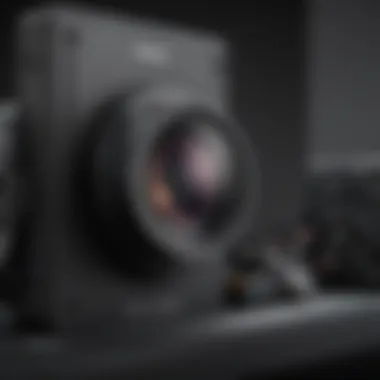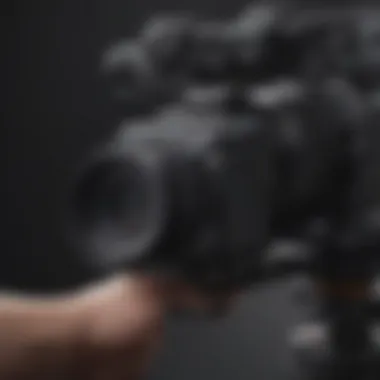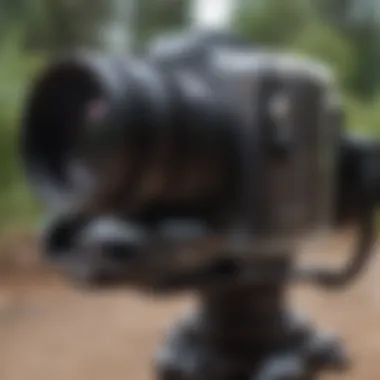Expert Guide: How to Mount a Blink Outdoor Camera Like a Pro


How to Mount a Blink Outdoor Camera: A Step-by-Step Guide
This article offers an in-depth exploration of the process of effectively mounting a Blink outdoor camera. From choosing the optimal location for installation to executing the setup with precision, each step is meticulously outlined to empower you to enhance the security of your property with ease and efficiency.
Key Elements of Mounting a Blink Outdoor Camera
To ensure the successful installation of your Blink outdoor camera, it is crucial to start by selecting an ideal location. This decision involves considering factors such as visibility, coverage, and accessibility to power sources. By strategically positioning the camera, you can maximize its effectiveness in monitoring your property.
Next, the process involves mounting the camera securely. This step necessitates the use of appropriate tools and hardware to affix the device to the chosen surface. Ensuring that the camera is stable and well-mounted is essential for maintaining its functionality and longevity.
Once the camera is mounted, attention shifts to the setup phase. This stage involves configuring the device, connecting it to the relevant app or system, and customizing settings as per your surveillance requirements. A thorough understanding of this process is vital for optimizing the camera's performance.
Importance of Proper Installation and Setup Maintenance
Properly mounting and setting up your Blink outdoor camera is not only about security but also about longevity and efficiency. A well-installed camera provides reliable surveillance and peace of mind. Regular maintenance and check-ups ensure that the camera continues to function optimally, contributing to the seamless monitoring of your surroundings.
Introduction to Blink Outdoor Camera
Wi-Fi-enabled outdoor security cameras are gaining popularity due to their ability to provide real-time monitoring and enhance property security. The Blink Outdoor Camera is a prominent choice for many, known for its user-friendly setup and reliable performance. Understanding the features and benefits of the Blink Outdoor Camera is crucial before delving into the installation process. The camera operates on a wireless system, allowing flexible placement and easy monitoring through a smartphone application. Key features include high-definition video recording, motion detection, and weather-resistant design, making it suitable for various outdoor environments. The importance of systematically mounting the Blink Outdoor Camera lies in optimizing its functionality and ensuring comprehensive surveillance of the surroundings.
Understanding the Blink Outdoor Camera
How the camera works
The Blink Outdoor Camera operates by connecting to a Wi-Fi network and transmitting video footage to the user's device. It utilizes motion sensors to detect movements within its range, triggering recording and sending alerts. This unique mechanism allows efficient monitoring without constant manual intervention. The wireless nature of the camera eliminates the need for complicated wiring, simplifying installation and placement options.
Key features and benefits
The Blink Outdoor Camera's standout features include night vision capability, two-way audio communication, and cloud storage for recordings. These features enhance its surveillance capabilities, making it a comprehensive security solution. Additionally, the camera's energy-efficient design prolongs battery life, ensuring continuous operation with minimal downtime. Such benefits make the Blink Outdoor Camera a preferred choice for users seeking reliable, easy-to-use security systems.


Importance of Proper Mounting
Enhancing security measures
Properly mounting the Blink Outdoor Camera enhances overall security measures by providing unobstructed views and maximizing surveillance coverage. Secure installation prevents tampering and ensures the camera remains in the desired position for effective monitoring. Strategic placement in key areas improves visibility and helps deter potential intruders, boosting property protection.
Optimizing camera effectiveness
Optimizing the camera's effectiveness involves selecting ideal mounting spots that offer optimal viewing angles and coverage. Proper positioning eliminates blind spots and enhances motion detection accuracy, crucial for timely notifications. Careful consideration of environmental factors, such as sunlight exposure and weather conditions, further enhances the camera's performance. Maintaining a balance between installation height and range ensures comprehensive monitoring without compromising image quality or detection capabilities.
Pre-Installation Preparation
Before delving into the physical aspect of mounting your Blink outdoor camera, it is crucial to undergo thorough pre-installation preparation. This stage sets the foundation for a successful installation process, ensuring optimal performance and functionality of your security device. Preparing adequately can save time and prevent common installation issues, making the entire process seamless and efficient.
Gathering Necessary Tools
When it comes to gathering the necessary tools for mounting your Blink outdoor camera, precision is key. Required tools and equipment encompass essentials such as a drill, screws, screwdriver, and a mounting bracket. Each tool plays a critical role in securing your camera effectively, with the quality and compatibility of these tools directly impacting the installation process's outcome.
- Required tools and equipment: The specified tools are essential elements for mounting your Blink outdoor camera securely. The drill facilitates creating holes for installation, while the screws and screwdriver are instrumental in affixing the camera in place. The mounting bracket provides the necessary support structure, ensuring the camera remains steady and aligned. Opting for high-quality tools enhances the durability and stability of the camera setup, ultimately safeguarding your property more effectively.
Choosing the Installation Location
Selecting the optimal installation location for your Blink outdoor camera warrants careful consideration. Ideal placement considerations revolve around factors like visibility, coverage area, and accessibility. Finding the perfect spot ensures maximum security coverage and minimizes blind spots, enhancing overall surveillance capabilities.
- Ideal placement considerations: The ideal placement considers factors such as a clear line of sight, minimal obstructions, and strategic positioning to capture crucial surveillance areas. Placing the camera at a higher vantage point can broaden the scope of coverage and deter tampering attempts. Additionally, installing the camera near power outlets or access points simplifies maintenance and monitoring tasks, streamlining the surveillance process.
- Factors affecting camera performance: Various factors, such as lighting conditions, Wi-Fi signal strength, and environmental interference, can impact the camera's performance. Understanding these influences allows for strategic placement to mitigate potential issues and optimize camera functionality. Positioning the camera away from direct sunlight or sources of glare prevents image distortion, ensuring clear and reliable surveillance footage.
Installation Process
Mounting a Blink Outdoor Camera involves a meticulous Installation Process that is crucial for the camera's effectiveness and security. The Installation Process ensures that the camera is correctly positioned to capture relevant footage and provide optimal protection. It begins with Mounting the Camera Bracket securely and then progresses to Attaching the Camera, fine-tuning the angle for maximum coverage.
Mounting the Camera Bracket


When Mounting the Camera Bracket, two key aspects are paramount: Securing the bracket in place and Ensuring stability.
Securing the bracket in place
Securing the bracket effectively guarantees the camera's stability and prevents any potential tampering. Bolting the bracket securely onto a surface adds a layer of security to the entire setup, safeguarding it against external elements or interference. This feature is highly beneficial as it ensures the camera remains in its intended position, capturing footage accurately.
Ensuring stability
Ensuring stability is vital for maintaining the camera's orientation over time. By securing the bracket with stability in mind, any vibrations or movements in the environment are minimized, resulting in clearer and more consistent video recordings. This characteristic is popular due to its ability to withstand varying weather conditions and external factors, providing reliable surveillance throughout the year.
Attaching the Camera
Attaching the Camera involves Connecting the camera to the bracket and Adjusting the angle to optimize its viewing range.
Connecting the camera to the bracket
Connecting the camera securely to the bracket is essential for seamless functionality. A firm connection ensures uninterrupted power and data transmission between the camera and bracket, allowing for continuous monitoring without any interruptions. This feature is advantageous as it maintains the camera's stability and ensures consistent performance.
Adjusting the angle
Adjusting the angle enables users to customize the camera's view, focusing on specific areas that require surveillance. By fine-tuning the angle, users can eliminate blind spots and enhance overall security coverage. This unique feature allows for versatility in monitoring different angles and positions, providing a comprehensive security solution.
Post-Installation Checks
Post-installation checks are a crucial part of ensuring the Blink outdoor camera functions optimally. Once the camera is securely mounted, conducting thorough tests is imperative to guarantee its effectiveness in monitoring your property. By verifying the live feed and checking motion detection, you can confirm that the camera is capturing clear footage and responding appropriately to movement. These checks are essential in identifying any potential issues early on and rectifying them promptly to maintain maximum security measures.
Testing Camera Functionality
Verifying live feed
Verifying the live feed is a critical aspect of post-installation checks. This process involves confirming that the camera is transmitting real-time footage to your connected device. By assessing the clarity and stability of the live feed, you can ensure that the camera provides continuous surveillance of the designated area. The live feed verification allows you to monitor any activity in the vicinity and address any discrepancies in the camera's performance promptly. This feature is highly beneficial for keeping a watchful eye on your property and enhancing overall security.


Checking motion detection
Checking motion detection is another essential component of post-installation checks. This involves testing the camera's ability to detect and capture motion accurately. By evaluating the responsiveness of the motion detection feature, you can ensure that the camera records any movement efficiently. Understanding how motion detection works and its sensitivity level is crucial in minimizing false alarms while maximizing the camera's efficacy. This feature offers the advantage of immediate notification regarding any suspicious activity, contributing significantly to enhancing security measures.
Optimizing Camera Settings
Adjusting sensitivity
Adjusting the sensitivity of the camera's motion detection is paramount in optimizing its performance. By fine-tuning the sensitivity levels based on your specific requirements, you can avoid unnecessary alerts triggered by non-threatening movements while ensuring prompt notifications for potential security threats. Finding the ideal sensitivity setting strikes a balance between detecting relevant activities and minimizing false alarms, enhancing the overall effectiveness of the camera in monitoring your surroundings. This feature enables you to customize the camera's response according to the environment it is surveilling, promoting efficient security monitoring.
Customizing alerts
Customizing alerts allows you to personalize the notifications received from the Blink outdoor camera. By selecting the type of alerts you want to receive and when you wish to be notified, you can tailor the camera's alert system to suit your preferences. This customization feature empowers you to stay informed about specific events or movements detected by the camera, contributing to a more personalized and user-oriented surveillance experience. The ability to customize alerts enhances the camera's usability, providing you with relevant information in a timely manner to address security concerns effectively.
Maintenance and Troubleshooting
In the realm of mounting a Blink Outdoor Camera, understanding maintenance and troubleshooting is key to ensuring the continued functionality and effectiveness of your security system. Maintenance plays a vital role in preserving the longevity of your equipment and maximizing performance. Troubleshooting, on the other hand, allows you to address and rectify any issues that may arise, ensuring uninterrupted surveillance of your property.
Regular Maintenance Practices
Cleaning the Camera Lens
Cleaning the camera lens is a fundamental aspect of maintenance that significantly impacts the clarity and quality of your camera footage. By removing dirt, dust, and debris from the lens, you can enhance the accuracy of captured images and videos. This simple yet crucial task safeguards against blurry or obstructed visuals, allowing for optimal surveillance outcomes. Regularly cleaning the camera lens also reduces the risk of false motion detections caused by a dirty lens, improving overall system efficiency.
Ensuring Firmware Updates
Ensuring timely firmware updates is another essential maintenance practice that contributes to the reliability and security of your Blink Outdoor Camera. Firmware updates often contain bug fixes, security patches, and performance enhancements that strengthen the camera's operational capabilities. By keeping the camera's firmware up to date, you mitigate the risk of vulnerabilities that could compromise your surveillance system. These updates not only bolster the camera's defenses against potential threats but also introduce new features and functionalities that enhance overall user experience.
Troubleshooting Common Issues
No Connectivity Problems
Addressing no connectivity problems is imperative for maintaining a seamless connection between your Blink Outdoor Camera and the associated network. When troubleshooting connectivity issues, identifying potential sources of interference, configuring network settings, and ensuring adequate signal strength are paramount. By troubleshooting connectivity issues effectively, you can restore reliable communication between the camera and your monitoring device, ensuring uninterrupted access to live feeds and alerts.
Camera Positioning Issues
Resolving camera positioning issues is essential for optimizing surveillance coverage and maximizing the effectiveness of your Blink Outdoor Camera. Incorrect camera positioning can result in obscured views, blind spots, or inadequate area coverage, compromising the camera's surveillance capabilities. By troubleshooting and adjusting the camera's placement, you can eliminate positioning issues and ensure comprehensive monitoring of your property. Strategic camera positioning enhances security measures and improves the overall functionality of your outdoor security system.



